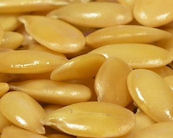Sunday, June 12th, 2011 at
7:16 pm
I was asked this question the other evening, so I had to do some research. The questioner was interested in a possible use for cancer. Obviously, we cannot say that anything will cure cancer. However, asking if a product will help is a good question. This post is the result of my initial research.
 The Mayo Clinic says that flaxseed contains some things that your body needs. These things include fiber (you know that is good for you, right?), omega-3 fatty acids (also helpful), and some chemicals called lignans.
The Mayo Clinic says that flaxseed contains some things that your body needs. These things include fiber (you know that is good for you, right?), omega-3 fatty acids (also helpful), and some chemicals called lignans.
So what exactly are lignans? My training as a pharmacist tells me that they have a very complex chemical structure, which I am not going to repeat here. Lignans are found in many plant products, although the greatest amounts are found in flaxseed and sesame seeds. The active ingredient is called secoisolariciresinal diglucoside, which usually gets shortened to SDG. SDG is broken down in the body, where it reacts with special structures called estrogen receptors (they come to life when the hormone estrogen becomes attached to them). This SDG is what has been investigated for possible anticancer effects in a number of clinical and animal studies.
Some types of cancer may respond to increased eating of flax seeds, but much of the research that shows up on PubMed (an index of articles that discuss treatments for diseases) is in mice or rats. Whether the findings in humans will match those in animals remains to be seen. The particular types of cancer that have been investigated include breast, colon, prostate, and skin. It appears that taking flax seed or that SDG that we talked about above, may be best in the very early stages of cancer, but again don’t stop taking the medicine that your doctor prescribes if you have been diagnosed with any of these diseases.
A recent study, published by Dr. Hijova and colleagues, from Safarikiensis University in Slovakia, was particularly interesting, so I took a look at the full article. These researchers gave rats a high-fat diet and then gave them a prebiotic alone or in combination with horse chestnut extract or flaxseed oil. Another group of animals got the prebiotic and both horse chestnut extract and flaxseed oil. What they found was that in the animals that got the treatments there was a reduction in concentrations of an enzyme that they say has been found to be increased in patients with colon cancer. There were also reductions in total cholesterol, triacylglycerols, and bile acids compared with animals that got only the prebiotic.
The design of this study doesn’t allow us to draw any conclusions about whether the same thing will happen in humans. The authors make a very valid point in their conclusion, however. That is that diet may be very important in prevention of disease, and the role of nutritional supplements, like flaxseed oil and horse chestnut extract, needs to be studied in the future.
Looking at the research that has been conducted that flaxseed or the oil that comes from the seeds may be helpful in improving the chances of medications working in a number of different areas. It appears that flaxseed may be good for you, with little risk of side effects. Of course, check with your doctor before taking flaxseed for any ‘medicinal’ purposes.
